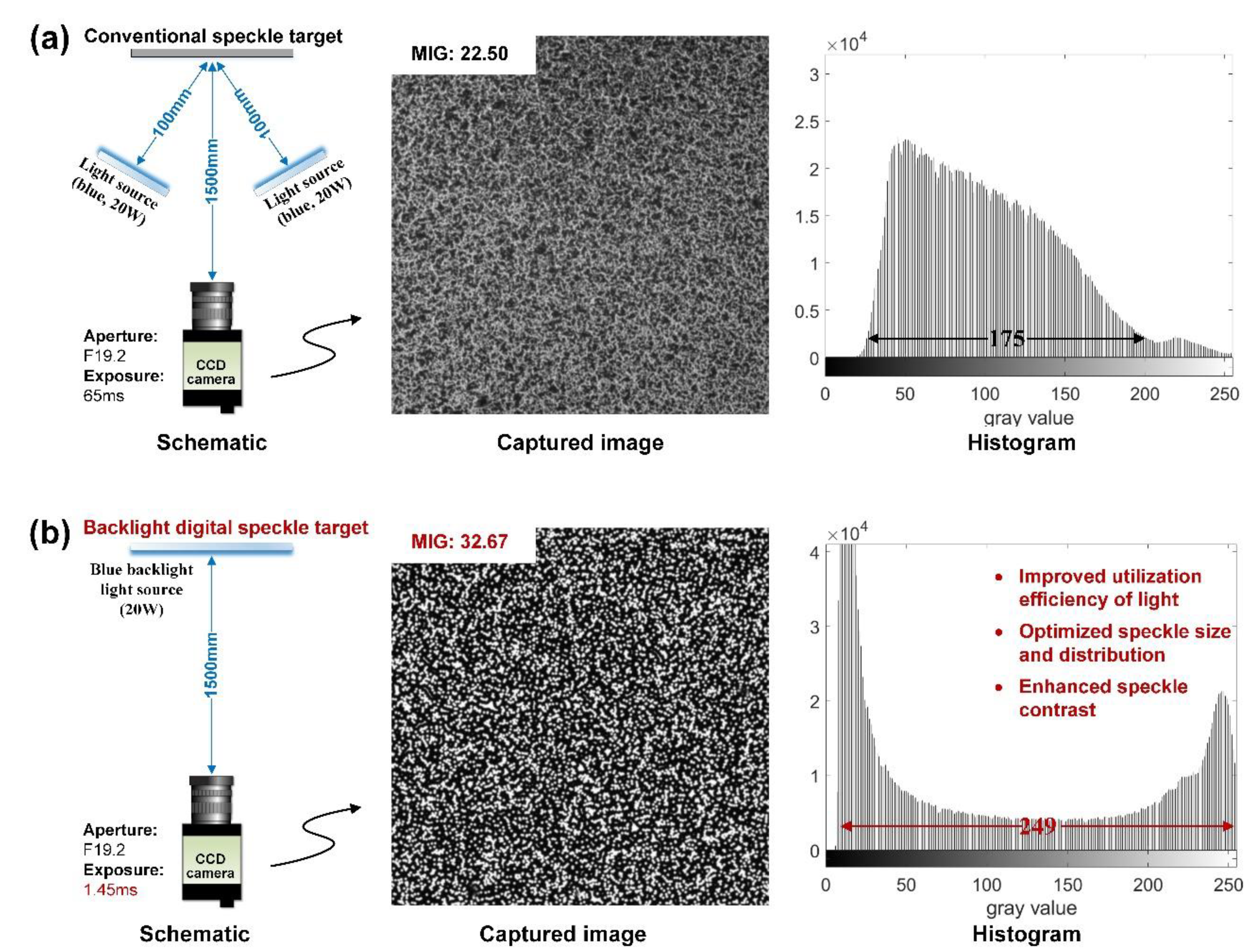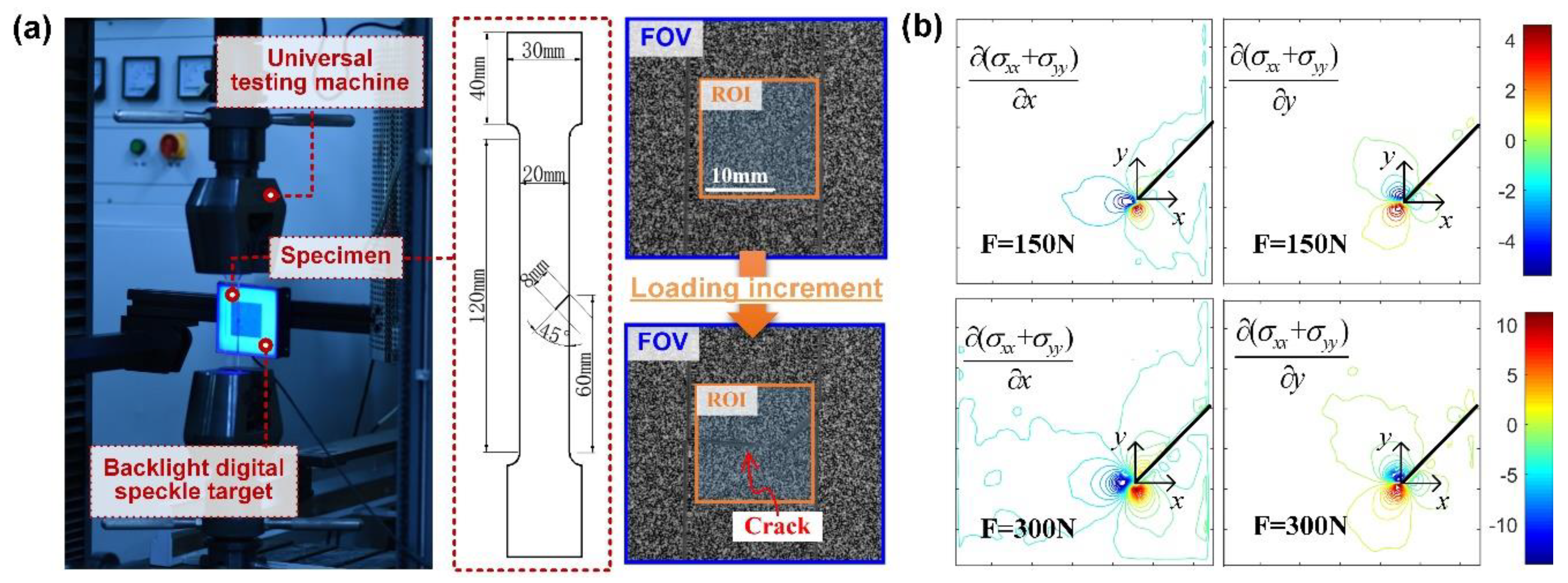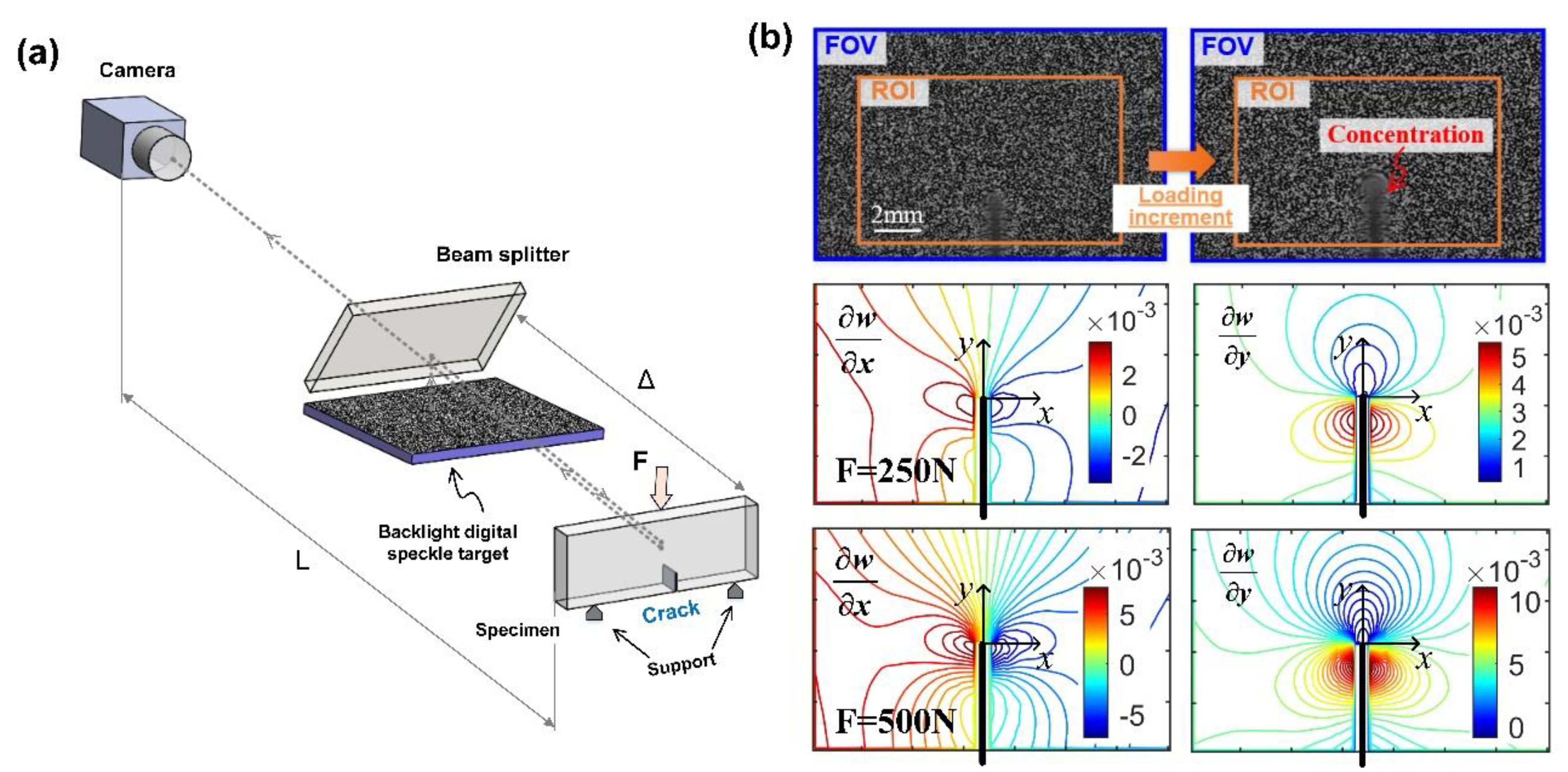Enhanced Digital Gradient Sensing Using Backlight Digital Speckle Target
Abstract
1. Introduction
2. Methodology
2.1. Digital Gradient Sensing
2.2. Backlight Digital Speckle Target
- (1)
- High dynamic measurement capability. The backlight speckle target selectively shades the blue backlight through the transparent/opaque texture of digital speckle layer, and allows the light emanating from the target to be captured by the imaging system directly, which can improve the utilization of light source, shorten the exposure time, and enhance the high-speed measurement performance of the system.
- (2)
- High measurement accuracy. The measurement accuracy of DGS is associated with the speckle size, speckle distribution, and speckle contrast. The proposed backlight digital speckle target utilizes the Gaussian speckle pattern simulation algorithm to generate the digital speckle pattern whose speckle size, density, and distribution can be designed to better match the real measurement scenario (e.g., the size of the specimen and the FOV). Therefore, the measurement accuracy of DGS can be improved after employing the digital speckle target [24]. In addition, the employment of backlight illumination can enhance the speckle contrast of the acquired speckle images [25]. The optimized speckle quality and contrast promote the accuracy of DIC point-wise tracking of displacement, and therefore, improves the DGS measurement accuracy.
- (3)
- High system integration and better operation. In conventional DGS methods, the speckle target and the lighting system are two separated parts. Before the measurement, the angle of the light source needs to be cumbersomely adjusted by the operator, so as to achieve the uniform illumination of the speckle target. The proposed backlight speckle target not only combines the illumination source and the speckle target, improving the system integration, but also effectively solves the tedious light source adjustment problem.
- (4)
- Strong robustness against the ambient light variation. The backlight speckle target adopts the blue backlight source and the corresponding blue bandpass filter to realize the blue light active imaging conveniently, which is expected to suppress the light variation in the ambient environment, and improve the stability and reliability of the measurement system [23].
- (5)
- High system compatibility. Compared with the simplified r-DGS method proposed by Tippur et al. [18], the backlight speckle target solution has higher system compatibility. That is, compatible with not only the conventional r-DGS but also the conventional t-DGS and the simplified r-DGS. The high compatibility greatly promotes the proposed speckle target to improve the light source utilization and integration of all DGS systems.
3. Experiments
3.1. Validation Experiment
3.2. Stress Gradient Field Measurement Using the Enhanced t-DGS
3.3. Plane Slope Measurement Using the Enhanced r-DGS
4. Conclusions
Author Contributions
Funding
Acknowledgments
Conflicts of Interest
References
- Periasamy, C.; Tippur, H.V. Full-field digital gradient sensing method for evaluating stress gradients in transparent solids. Appl. Opt. 2012, 51, 2088–2097. [Google Scholar] [CrossRef]
- Periasamy, C.; Tippur, H.V. A full-field reflection-mode digital gradient sensing method for measuring orthogonal slopes and curvatures of thin structures. Meas. Sci. Technol. 2013, 24, 025202. [Google Scholar] [CrossRef]
- Pan, B. Bias error reduction of digital image correlation using Gaussian pre-filtering. Opt. Lasers Eng. 2013, 51, 1161–1167. [Google Scholar] [CrossRef]
- Pan, B.; Li, K. A fast digital image correlation method for deformation measurement. Opt. Lasers Eng. 2011, 49, 841–847. [Google Scholar] [CrossRef]
- Periasamy, C.; Tippur, H.V. Measurement of crack-tip and punch-tip transient deformations and stress intensity factors using Digital Gradient Sensing technique. Eng. Fract. Mech. 2013, 98, 185–199. [Google Scholar] [CrossRef]
- Periasamy, C.; Tippur, H.V. Nondestructive evaluation of transparent sheets using a full-field digital gradient sensor. NDT E Int. 2013, 54, 103–106. [Google Scholar] [CrossRef]
- Periasamy, C.; Tippur, H.V. Measurement of Orthogonal Stress Gradients Due to Impact Load on a Transparent Sheet using Digital Gradient Sensing Method. Exp. Mech. 2013, 53, 97–111. [Google Scholar] [CrossRef]
- Hao, W.; Tang, C.; Yuan, Y.; Ma, Y. Study on the effect of inclusion shape on crack-inclusion interaction using digital gradient sensing method. J. Adhes. Sci. Technol. 2015, 29, 2021–2034. [Google Scholar] [CrossRef]
- Hao, W.; Tang, C.; Yuan, Y.; Yao, X.; Ma, Y. Experimental study on the fiber pull-out of composites using digital gradient sensing technique. Polym. Test. 2015, 41, 239–244. [Google Scholar] [CrossRef]
- Zhang, R.; Guo, R.; Cheng, H. Numerical-experimental hybrid method for stress separation in digital gradient sensing method. Opt. Lasers Eng. 2015, 66, 122–127. [Google Scholar] [CrossRef]
- Hao, W.; Chen, X.; Yuan, Y.; Ma, Y. Experimental Investigation on Curing Stress in Polymer Composite Using Digital Gradient Sensing Technique. Int. Polym. Process. 2016, 31, 57–67. [Google Scholar] [CrossRef]
- Hao, W.; Tang, C.; Ma, Y. Study on crack-inclusion interaction using digital gradient sensing method. Mech. Adv. Mater. Struct. 2016, 23, 845–852. [Google Scholar] [CrossRef]
- Miao, C.; Sundaram, B.M.; Huang, L.; Tippur, H.V. Surface profile and stress field evaluation using digital gradient sensing method. Meas. Sci. Technol. 2016, 27, 095203. [Google Scholar] [CrossRef]
- Sundaram, B.M.; Tippur, H.V. Dynamic Crack Growth Normal to an Interface in Bi-Layered Materials: An Experimental Study Using Digital Gradient Sensing Technique. Exp. Mech. 2016, 56, 37–57. [Google Scholar] [CrossRef]
- Miao, C.; Tippur, H.V. Higher sensitivity Digital Gradient Sensing configurations for quantitative visualization of stress gradients in transparent solids. Opt. Lasers Eng. 2018, 108, 54–67. [Google Scholar] [CrossRef]
- Dondeti, S.; Tippur, H.V. A Comparative Study of Dynamic Fracture of Soda-Lime Glass Using Photoelasticity, Digital Image Correlation and Digital Gradient Sensing Techniques. Exp. Mech. 2020, 60, 217–233. [Google Scholar] [CrossRef]
- Miao, C.; Tippur, H.V. Dynamic Fracture of Soda-lime Glass Plates Studied using Two Modified Digital Gradient Sensing Techniques. Eng. Fract. Mech. 2020, 107048. [Google Scholar] [CrossRef]
- Miao, C.; Tippur, H.V. A simplified reflection-mode digital gradient sensing technique for measuring surface slopes, curvatures and topography. Opt. Lasers Eng. 2020, 124, 105843. [Google Scholar] [CrossRef]
- Hu, Y.; Wang, S.; Cheng, X.; Xu, C.; Hao, Q. Dynamic Deformation Measurement of Specular Surface with Deflectometry and Speckle Digital Image Correlation. Sensors 2020, 20, 1278. [Google Scholar] [CrossRef]
- Zhang, X.; Li, D.; Wang, R.; Tang, H.; Luo, P.; Xu, K. Speckle pattern shifting deflectometry based on digital image correlation. Opt. Express 2019, 27, 25395–25409. [Google Scholar] [CrossRef]
- Bing, P.; Hui-Min, X.; Bo-Qin, X.; Fu-Long, D. Performance of sub-pixel registration algorithms in digital image correlation. Meas. Sci. Technol. 2006, 17, 1615. [Google Scholar] [CrossRef]
- Chen, Z.; Quan, C.; Zhu, F.; He, X. A method to transfer speckle patterns for digital image correlation. Meas. Sci. Technol. 2015, 26, 095201. [Google Scholar] [CrossRef]
- Pan, B.; Wu, D.; Xia, Y. An active imaging digital image correlation method for deformation measurement insensitive to ambient light. Opt. Laser Technol. 2012, 44, 204–209. [Google Scholar] [CrossRef]
- Pan, B.; Lu, Z.; Xie, H. Mean intensity gradient: An effective global parameter for quality assessment of the speckle patterns used in digital image correlation. Opt. Lasers Eng. 2010, 48, 469–477. [Google Scholar] [CrossRef]
- Available online: https://www.vision-doctor.com/en/illumination-techniques/backlight-illumination.html (accessed on 16 November 2020).
- Chen, B.; Liu, H.; Pan, B. Calibrating stereo-digital image correlation system using synthetic speckle-pattern calibration target. Meas. Sci. Technol. 2020, 31, 095004. [Google Scholar] [CrossRef]
- Chen, Z.; Shao, X.; Xu, X.; He, X. Optimized digital speckle patterns for digital image correlation by consideration of both accuracy and efficiency. Appl. Opt. 2018, 57, 884–893. [Google Scholar] [CrossRef]
- Bruck, H.A.; McNeill, S.R.; Sutton, M.A.; Peters, W.H. Digital image correlation using Newton-Raphson method of partial differential correction. Exp. Mech. 1989, 29, 261–267. [Google Scholar] [CrossRef]
- Pan, B.; Li, K.; Tong, W. Fast, Robust and Accurate Digital Image Correlation Calculation without Redundant Computations. Exp. Mech. 2013, 53, 1277–1289. [Google Scholar] [CrossRef]
- Dong, B.; Li, C.; Pan, B. Fluorescent digital image correlation applied for macroscale deformation measurement. Appl. Phys. Lett. 2020, 117, 044101. [Google Scholar] [CrossRef]





| Aperture Size | Exposure Time (Conventional Method) | Exposure Time (Backlight Method) | Comparison |
|---|---|---|---|
| F19.2 (small) | 65,000 us | 1450 μs | 44.8 times decreased |
| F9.6 (medium) | 13,500 us | 380 μs | 35.5 times decreased |
| F6.4 (medium) | 8300 us | 220 μs | 37.7 times decreased |
| F4.8 (large) | 5000 us | 125 μs | 40.0 times decreased |
| Aperture Size | MIG (Conventional Method) | MIG (Backlight Method) | Comparison |
|---|---|---|---|
| F19.2 (small) | 22.50 | 32.67 | 45.2% improved |
| F9.6 (medium) | 25.93 | 33.51 | 29.2% improved |
| F6.4 (medium) | 24.81 | 34.43 | 38.7% improved |
| F4.8 (full) | 24.34 | 35.86 | 47.3% improved |
Publisher’s Note: MDPI stays neutral with regard to jurisdictional claims in published maps and institutional affiliations. |
© 2020 by the authors. Licensee MDPI, Basel, Switzerland. This article is an open access article distributed under the terms and conditions of the Creative Commons Attribution (CC BY) license (http://creativecommons.org/licenses/by/4.0/).
Share and Cite
Fu, B.; Li, C.; Dong, B.; Ou, P. Enhanced Digital Gradient Sensing Using Backlight Digital Speckle Target. Sensors 2020, 20, 6557. https://doi.org/10.3390/s20226557
Fu B, Li C, Dong B, Ou P. Enhanced Digital Gradient Sensing Using Backlight Digital Speckle Target. Sensors. 2020; 20(22):6557. https://doi.org/10.3390/s20226557
Chicago/Turabian StyleFu, Baofei, Chenzhuo Li, Bo Dong, and Pan Ou. 2020. "Enhanced Digital Gradient Sensing Using Backlight Digital Speckle Target" Sensors 20, no. 22: 6557. https://doi.org/10.3390/s20226557
APA StyleFu, B., Li, C., Dong, B., & Ou, P. (2020). Enhanced Digital Gradient Sensing Using Backlight Digital Speckle Target. Sensors, 20(22), 6557. https://doi.org/10.3390/s20226557





